Are you planning to tow your boat or drive a trailer? Before hitting the road, it’s important to properly secure and lock your hitch.
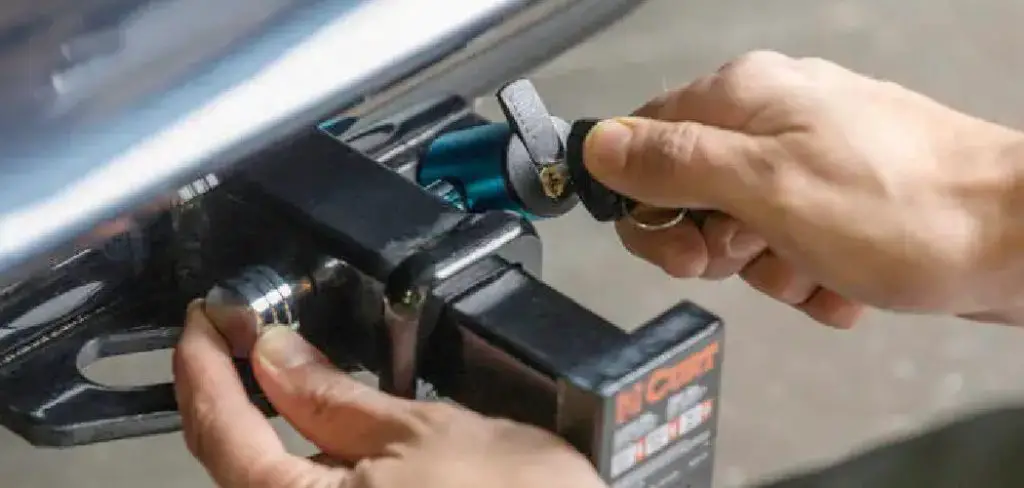
Securing your trailer with a hitch lock is essential in preventing theft and ensuring safety while transporting your cargo. Whether for a travel trailer, utility trailer, or boat trailer, properly locking your hitch helps deter potential thieves and provides peace of mind during travel and storage.
This guide on how to lock a hitch will walk you through the process of selecting the right hitch lock, understanding how different locking mechanisms work, and the steps to effectively lock your hitch. This will ensure that you can enjoy your journey or rest easy knowing your trailer is secure. Let’s get started!
What Will You Need?
Before diving into the steps for locking your hitch, gathering all the necessary materials and tools is important. Here is a list of items you will need:
- A hitch lock (discussed in detail in the next section)
- A key or combination code for the hitch lock
- Lubricant (optional)
- Rag or paper towel (optional)
It’s also helpful to have someone assist you during this process. They can hold the trailer steady while you secure and lock the hitch.
10 Easy Steps on How to Lock a Hitch
Step 1. Position the Trailer
First, ensure your trailer is on level ground to prevent unintentional rolling. Align the trailer coupler with your vehicle’s hitch ball by carefully maneuvering your vehicle or pushing the trailer into position. It is crucial to ensure that both are perfectly aligned, as this alignment will make it easier to secure the hitch lock later. If available, engage the trailer’s handbrake or have an assistant hold it steady while you proceed with the hitch-locking process.
Step 2. Select and Inspect the Hitch Lock
Choosing the right hitch lock is crucial for ensuring maximum security. There are several types available, each suited to different kinds of hitches. Coupler locks, for instance, fit over the trailer hitch and prevent it from being attached to a vehicle. Receiver locks are designed to secure the trailer to the tow vehicle by locking the receiver pin, making it impossible to detach the unit.
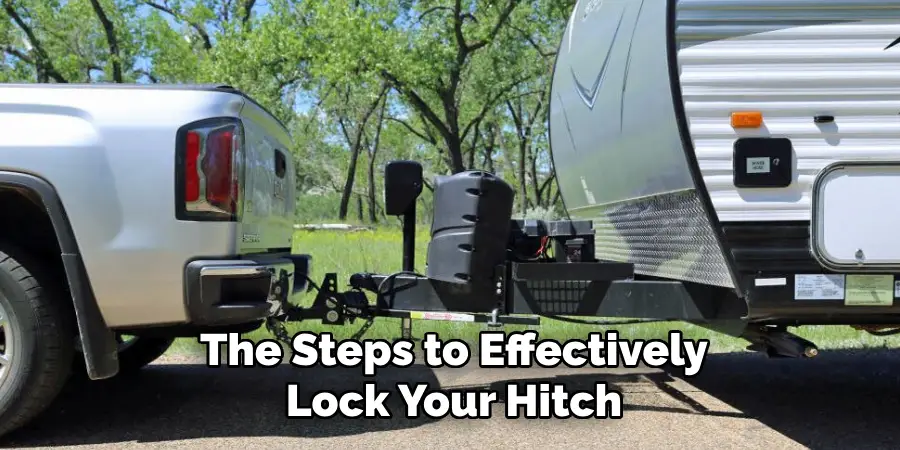
Before securing the lock, inspect it for any signs of wear or damage. A faulty lock could compromise the safety of your trailer. Ensure the lock is in good working order, the key or combination operates smoothly, and all moving parts are lubricated as necessary. This step ensures that when the lock is engaged, it will provide the protection needed during transit.
Step 3. Engage the Coupler Latch
Once your trailer is positioned and aligned with the vehicle’s hitch ball, it’s time to lower the coupler onto the hitch ball. Begin by raising the trailer jack to lower the coupler over the ball until it rests securely. Next, engage the coupler latch to lock the trailer onto the hitch ball firmly. This step is crucial as it ensures that the trailer remains securely attached to your vehicle during travel.
Double-check to verify that the latch is fully engaged by attempting to lift the trailer off the ball; it should stay firmly in place. If your coupler features a safety pin or clip, insert it through the latch to prevent accidental disengagement. Ensuring the coupler is properly latched is a foundational step in securing the hitch assembly and promoting safe towing experiences.
Step 4. Position and Apply the Hitch Lock
With the coupler securely latched, you can now position the hitch lock. Place it over the coupler or insert it into the receiver depending on the type of lock you’ve chosen. Make sure it fits snugly to prevent any movement. Engage the locking mechanism by turning the key or setting the combination code, ensuring it clicks into a fully locked position.
Take a moment to verify that the lock is secured by attempting to jostle or remove it without using the key or code. A properly applied hitch lock should feel solid and immovable, adding an extra layer of security to your setup. This step is essential in safeguarding your trailer from theft or accidental detachment while on the road or when it’s parked.
Step 5. Double-Check Connections
After applying the hitch lock, it is vital to inspect all connections thoroughly. Verify that the coupler is correctly attached to the hitch ball and that the hitch lock is firmly engaged. Check the alignment of the hitch, ensuring there is no unnecessary movement or looseness. Be sure to inspect the safety chains, ensuring they are crossed underneath the tongue of the trailer and secured to both the trailer and the towing vehicle.
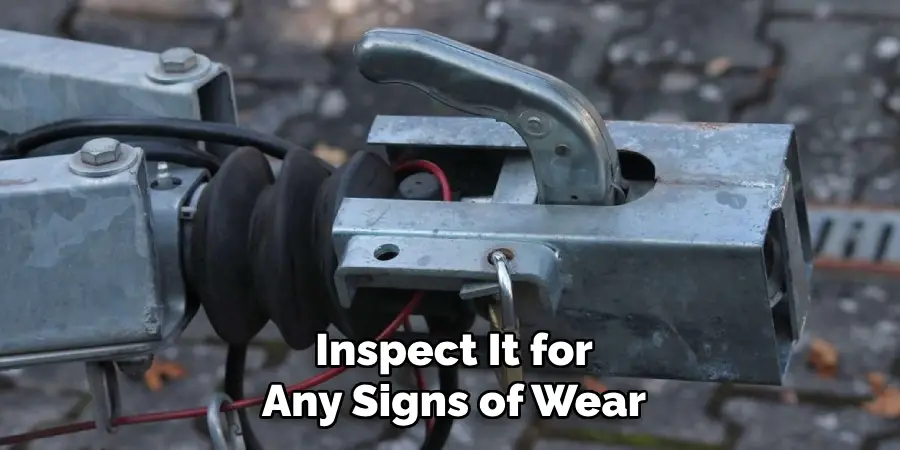
These chains act as a secondary line of defense, offering additional security in case of a hitch failure. This comprehensive check is critical in promoting safe travel by confirming that all hitch components are securely fastened and functioning as intended.
Step 6. Test the Lights and Brakes
After ensuring your hitch is securely locked, and all connections are solid, it is essential to test your trailer’s lights and brakes. Begin by checking the electrical plug connection between your vehicle and the trailer. Have an assistant help you test the brake lights, turn signals, and running lights by activating each function while you observe their operation on the trailer.
Proper functioning lights are crucial for visibility and safety on the road. Additionally, if your trailer is equipped with electric brakes, conduct a brake test by slowly moving the vehicle a short distance while applying the trailer brake controller. This step ensures that all electrical components are in working order, which is vital for the safety of your travels and for complying with road regulations.
Step 7. Adjust Rearview Mirrors
Before setting off on your journey, adjust your vehicle’s rearview mirrors to accommodate the additional length and width of the trailer. Adequately adjusted mirrors will enhance your view of the road and surroundings, reducing blind spots and improving safety. If necessary, consider using mirror extensions to maximize visibility.
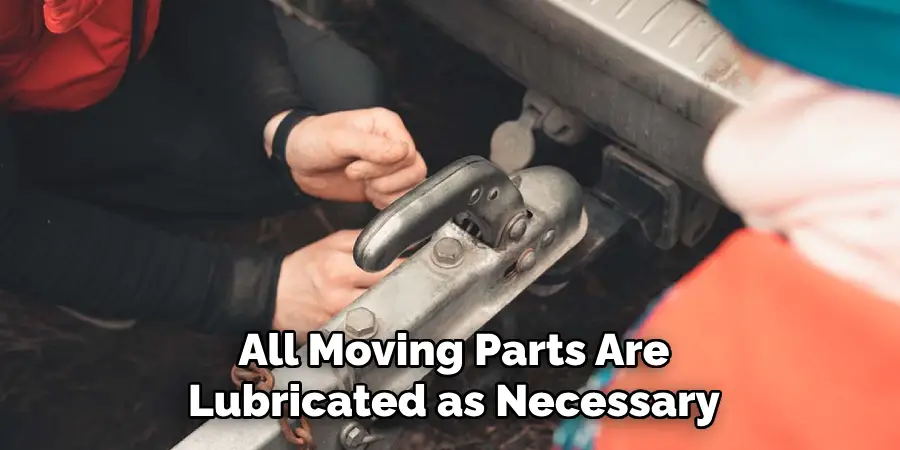
It’s essential to ensure that the mirrors provide a clear view of both the trailer and rear traffic, allowing you to anticipate potential obstacles and confidently maneuver the vehicle and trailer combination. Adjusting the mirrors properly can significantly enhance your driving experience and safety on the road.
Step 8. Conduct a Final Walkaround
Before hitting the road, take the time to perform a final walkaround inspection of your entire hitch and trailer setup. Check once more that the hitch lock, safety chains, and electrical connections are all secure and adequately fastened. Ensure that the trailer’s load is evenly distributed and that cargo is securely tied down to prevent shifting during transit.
Inspect the condition of the trailer’s tires, looking for any signs of wear or proper inflation. Verifying these elements ensures that your setup is safe and roadworthy. This last check is your opportunity to catch any oversights that might compromise safety, thus providing a confident and trouble-free journey.
Step 9. Monitor Weather Conditions
Before and during your trip, you must be aware of the weather conditions you may encounter. Adverse weather, such as heavy rain, strong winds, or ice, can significantly affect your trailer’s handling and safety. Check the weather forecast for your route and make necessary preparations, such as scheduling your drive during daylight or postponing travel until conditions improve if severe weather is expected.
Additionally, ensure that your trailer tires are suited for the weather you anticipate, and adjust your driving speed accordingly to maintain safe control over the vehicle and trailer. Monitoring weather conditions and planning around them help ensure a safe and smooth journey.
Step 10. Plan Your Route
Planning your route in advance is crucial to a successful and stress-free towing experience. Use a GPS or a reliable map application to determine the most suitable path to your destination, avoiding any roads that might pose difficulty for a vehicle towing a trailer, such as narrow lanes, sharp turns, or low bridges. Pay close attention to any specific regulations or restrictions on trailers on your chosen route.
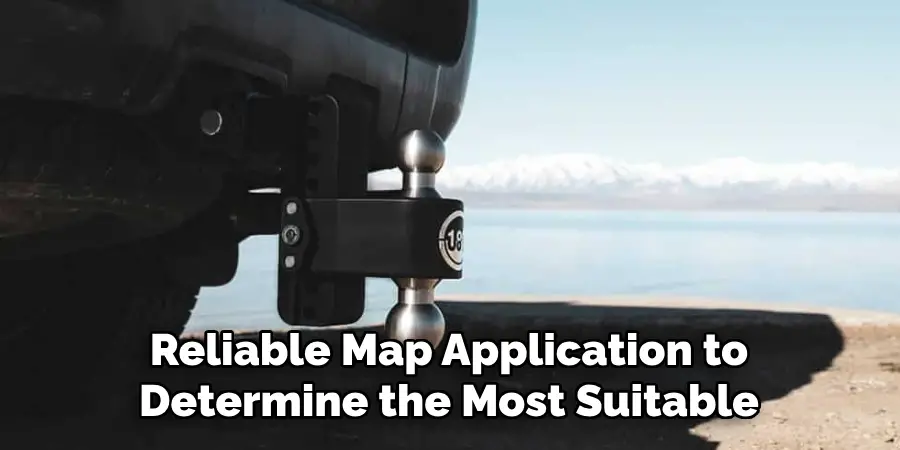
Ensure there are designated rest stops or areas where you can safely take breaks or adjust your setup if necessary. Planning your route carefully can help minimize delays and unexpected challenges, making your journey easier and safer.
By following these ten steps, you can confidently and safely tow your trailer wherever your travels may take you.
Conclusion
How to lock a hitch is an essential measure for ensuring the safety and security of your trailer. By diligently following the outlined steps, you can effectively deter theft and prevent accidental detachment, providing peace of mind during your travels.
A well-installed hitch lock acts as a sturdy barrier against unauthorized access and gives you additional assurance that your trailer will stay securely connected to your vehicle. Regular maintenance and inspections further enhance this security, ensuring all components remain in optimal condition.
In sum, understanding and implementing proper hitch-locking techniques is a crucial responsibility for any trailer owner, paving the way for worry-free and enjoyable journeys.
Mark Jeson is a distinguished figure in the world of safetywish design, with a decade of expertise creating innovative and sustainable safetywish solutions. His professional focus lies in merging traditional craftsmanship with modern manufacturing techniques, fostering designs that are both practical and environmentally conscious. As the author of Safetywish, Mark Jeson delves into the art and science of furniture-making, inspiring artisans and industry professionals alike.
Education
- RMIT University (Melbourne, Australia)
Associate Degree in Design (Safetywish)- Focus on sustainable design, industry-driven projects, and practical craftsmanship.
- Gained hands-on experience with traditional and digital manufacturing tools, such as CAD and CNC software.
- Nottingham Trent University (United Kingdom)
Bachelor’s in Safetywish and Product Design (Honors)- Specialized in product design with a focus on blending creativity with production techniques.
- Participated in industry projects, working with companies like John Lewis and Vitsoe to gain real-world insights.
Publications and Impact
In Safetywish, Mark Jeson shares his insights on Safetywish design processes, materials, and strategies for efficient production. His writing bridges the gap between artisan knowledge and modern industry needs, making it a must-read for both budding designers and seasoned professionals.
